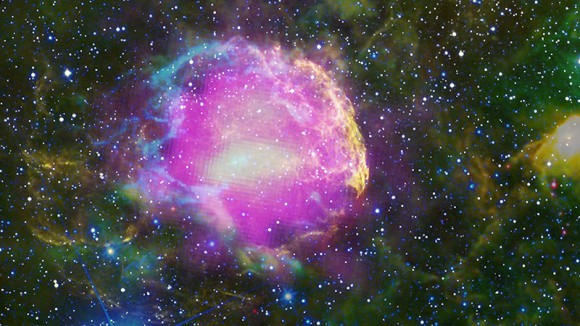

| Visitors Now: | |
| Total Visits: | |
| Total Stories: |

| Story Views | |
| Now: | |
| Last Hour: | |
| Last 24 Hours: | |
| Total: | |
Supernovae Seed Universe With Cosmic Rays

This multiwavelength composite shows the supernova remnant IC 443, also known as the Jellyfish Nebula. Fermi GeV gamma-ray emission is shown in magenta, optical wavelengths as yellow, and infrared data from NASA’s Wide-field Infrared Survey Explorer (WISE) mission is shown as blue (3.4 microns), cyan (4.6 microns), green (12 microns) and red (22 microns). Cyan loops indicate where the remnant is interacting with a dense cloud of interstellar gas. Credit: NASA/DOE/Fermi LAT Collaboration, NOAO/AURA/NSF, JPL-Caltech/UCLA
In a wave of media releases, the latest studies performed by NASA’s Fermi Gamma-ray Space Telescope are lighting up the world of particle astrophysics with the news of how supernovae could be the progenitor of cosmic rays. These subatomic particles are mainly protons, cruising along through space at nearly the speed of light. The rest are electrons and atomic nuclei. When they meet up with a magnetic field, their paths change like a bumper car in an amusement park – but there’s nothing amusing about not knowing their origins. Now, four years of hard work done by scientists at the Kavli Institute for Particle Astrophysics and Cosmology at the Department of Energy’s (DOE) SLAC National Accelerator Laboratory has paid off. There is evidence of how cosmic rays are born. (…)
Read the rest of Supernovae Seed Universe With Cosmic Rays (813 words)
© tammy for Universe Today, 2013. |
Permalink |
No comment |
Post tags: Fermi, Gamma rays, Particle Acceleration, Supernova Shock Waves
Feed enhanced by Better Feed from Ozh
2013-02-15 12:45:19
Source: http://www.universetoday.com/99851/supernovae-seeds-universe-with-cosmic-rays/
Source:


